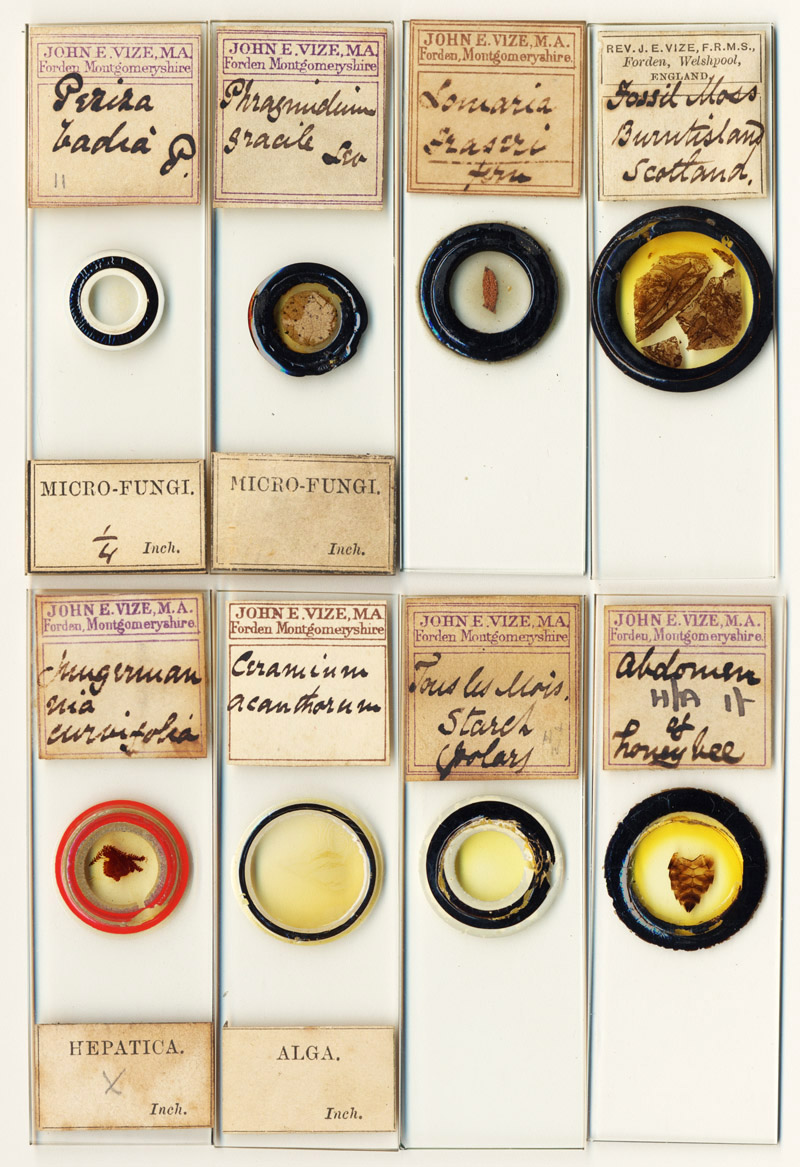
Figure 1. A selection of microscope slides by J.E. Vize. Although he is best known for his research on fungi, Vize mounted a wide variety of objects.
Reverend John Edward Vize, 1831-1916
by Brian Stevenson
last updated September, 2013
John Vize was a classic example of a Victorian English scientist, being an educated man with sufficient spare time and energy to investigate the workings of the world around him. Vize was an ordained Anglican minister. Throughout much of his life, he involved himself with the local scientific community wherever he was stationed. Vize’s studies emphasized fungi, particularly those which required a microscope for investigation. However, surviving slides and other historical records indicate a broad range of interests. He also wrote extensively about the history of Forden, Wales, where he spent several decades as Vicar.

Figure 1.
A selection of microscope slides by
J.E. Vize. Although he is best known for his research on fungi, Vize mounted a
wide variety of objects.
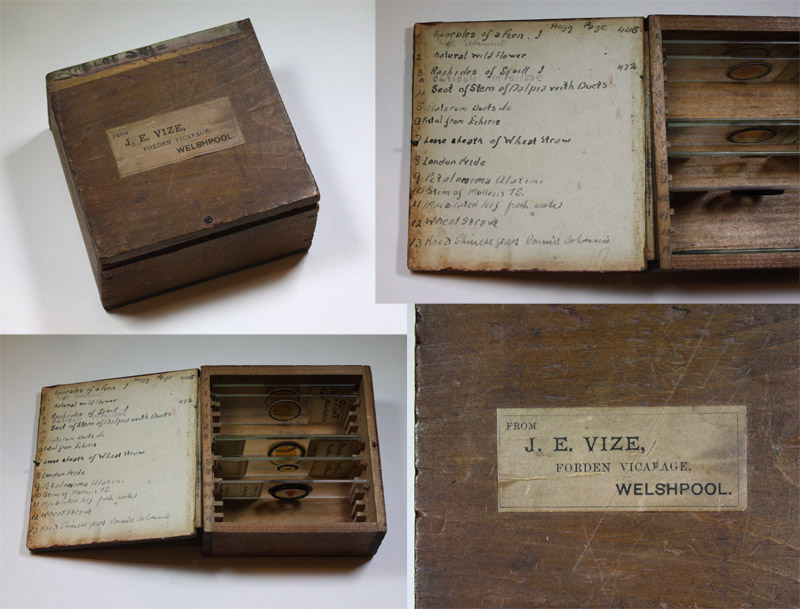
Figure 2.
A labeled shipping box from Vize,
presumably used to deliver a slide order to a customer. His handwritten list
inside the lid describes 15 botanical specimens. The box has a cloth hinge, and
was held shut with a nail.
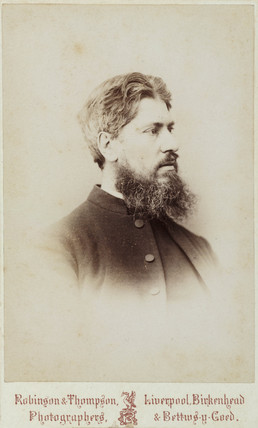
Figure 3.
An undated cdv photograph of J.E. Vize. Used for nonprofit, educational purposes, the original source is not known.
John Edward Vize was born in St. Mary-le-Bone (Marylebone), London, on 7 March 1831. He was the first child of John and Matilda (nee Lucy) Vize. The son was christened shortly after his birth, at St. Mary’s, and again 1832 at his mother’s home town in Warwickshire, presumably for the benefit of Matilda’s family. The Vizes were moderately well-off, benefiting from inheritances off both sides of the family. At the time of young John’s birth, his father was a bookseller and operator of a circulating library. John senior’s business failed in 1832, and he turned to teaching school. When young John was 6, his mother died of tuberculosis, as did also his newborn baby brother. John senior died in 1840, also from tuberculosis, orphaning 9 year-old John Edward and his two younger siblings. However, they had inherited substantial sums from their grandparents, and the 1841 census reported that they had “independent means”. They apparently lived for several more years with an uncle’s family in Hackney, London. John initially began to work as an accountant, then switched to the clergy.
John took a position as Curate in Bath, Somerset, by 1854, although he was not yet formally qualified. In 1855, he married Hannah Louisa Ashley, who was 13 years his senior. They then moved to Dublin, Ireland, where John earned his Bachelor of Divinity at Trinity College in 1857. During his studies, he served as the Curate of Bray, in County Wicklow. He was ordained in 1858 and became Vicar of Bray in 1859. The couple had a son, Thomas, while in Dublin. Three more children where born in Bray, although only one, Clara, survived infancy.
By 1861, Vize had taken a position in Corsham, Wiltshire, not far from Hannah’s home of Bath. John completed a Masters of Divinity at Oxford University in 1863. This is the “M.A.” to which Vize refers on many of his slide labels. In 1864, he was appointed to the Parish of Bath.
Vize was next posted as Vicar of St Mary’s in Hulme (modern day south Manchester), in 1866. It was here that Vize began making a significant mark in microscopy. He was an active, curious member of the Microscopical and Natural History Section of the Manchester Literary and Philosophical Society. For example, on February 25, 1867, he “exhibited and described the hairs of a foreign Lepidopterous caterpillar. He said the specimen had remained for many years in spirit, and no record had been preserved with it; it was evidently not British, but he had hitherto been unable to identity it with any described foreign species in books to which he had access. The body was covered with very large compound hairs which gave the entire creature the appearance of a tuft of moss, and might possibly serve for its protection by the likeness to a vegetable growth. The unusual and peculiar development of these hairs suggested a microscopical examination of them, and the result had been interesting as showing that, whether or not the entire mass of the compound hairs serve for protection by concealment, the complex structure of their points, which are capable of protrusion and have each a bag or gland at their base contained within the tubular branch from which they project, fits them to act as most efficient weapons of offence”.
Also in 1867, he was a founding member of Manchester’s Leeuwenhoek Microscopical Club. Vize served as the first president of this elite group of seven microscopists. Further details on that Club may be read in the biography of John Boyd on this site. Vize resigned his presidency in late 1868, in anticipation of his moving to Wales.
Vize became Vicar of Forden, Montgomeryshire, Wales in 1869. He also served as Chaplain for the Forden Union Workhouse. Son Thomas was placed at a boarding school in Gloucestershire, while daughter Clara stayed with her maiden aunts, who ran a school for girls.
John’s fascination with fungi was evidently well established by the time he reached Forden. In 1871, he sent his old colleagues in Manchester a slide of Xenodochus carbonarius: “Mr. Vize reported that this rare fungus occurs near Welshpool, in a railway cutting, with a south-westerly aspect, well sheltered by a hill and a wood. The first appearance on the leaves of Sanguisorba officinalis, L., was noticed in the middle of May, when the Lecythea-form was in perfection, but the stems and other portions of the Burnet were greatly distorted by it. A month afterwards the magnificent vermilion-coloured spores were well sprinkled over the leaves, the form of which was unaltered. In the middle of July the intensely black brand spores made their appearance, many of which had twenty or more articulations, and were plentifully scattered over the leaves in tufts. Mr. Vize stated that he had not watched the transition state from the Uredo to brand-spores, but he hoped to do so if opportunity offered”.
Within a few years of that donation and report, Vize began sharing his microscope slides nationwide. In 1877, the Royal Microscopical Society’s Monthly Microscopical Journal reported, “A recent number of 'Grevillea' contains the following notice, which may be of interest to some of our readers. ‘For many years the want has been widely felt of some one with a practical knowledge of fungi, and withal expert in their manipulation, who could prepare for those who were unable to do it for themselves, mycological slides. We have often been applied to during the past to indicate such a person, if he could be found, and the application has been fruitless. This, however, is no longer the case, for we have had the opportunity of examining some of the microscopical preparations of fungi which have been produced by the Rev. J.E. Vize, of Forden Vicarage, Welshpool, and do not hesitate to recommend them to any of our readers who may be in search of such aids to study. It may be observed that no small advantage results from the manipulator being himself a mycologist, consequently the preparations are scientifically and accurately named, to say nothing of the neat and business-like manner in which the mechanical work of manipulation is performed. Here, then, is an excellent opportunity for anyone to possess themselves of illustrations of the principal genera of microscopical fungi, any such a series being manufactured to order. We are also further informed that anyone who is desirous of doing so may have their own material mounted, so that nothing more remains to be desired, except it be a reasonable and economical scale of charges, which, in this instance also, will be found entirely to their satisfaction. We can only hope that such invaluable aids to the study of fungi will not be neglected, and that Mr. Vize's unique and artistic preparations will find a place in every microscopical cabinet, whether specially devoted to mycological subjects or not’.”
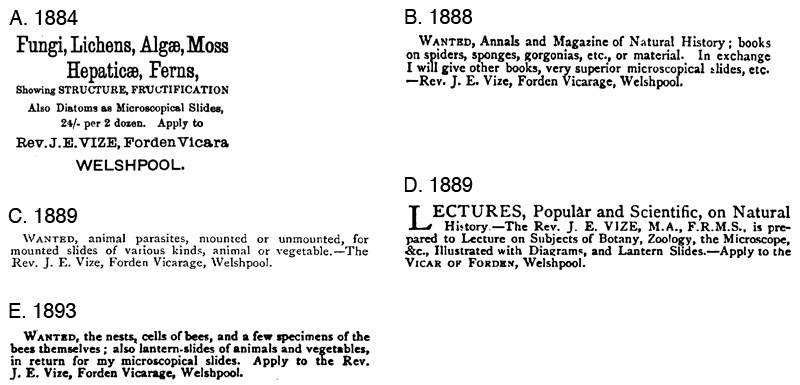
Figure 4.
Some advertisements and exchange offers from J.E. Vize.
In addition to affording him the time to study fungi, Vize’s position also allowed him to travel to London with some frequency. He was present at the May 1, 1878 meeting of the Royal Microscopical Society, and participated in a discussion of fungi on plant leaves. The minutes of the meeting make it clear that he was regarded as an expert in the field. Vize was elected Fellow of the RMS in 1879. Rare slide labels from Vize describe him as “Rev. J.E. Vize, F.R.M.S.”, and probably date from around the time of his election. Most slides bear the description “John E. Vize, M.A.” which, from their relative abundance, were probably in use both before and after Vize’s election. To answer Brian Bracegirdle’s question in Microscopical Mounts and Mounters (which was perhaps asked tongue-in-cheek), all known slides from Vize date from after he took his holy orders.
Vize traveled to Liverpool for a February 26, 1880 presentation of the Chester Society of Natural Science on "the fungus of diphtheria," (since recognized to be a bacterium). He was also recorded as attending the May 2, 1882, meeting of the Birmingham Natural History and Microscopical Society, where he “read a paper on English Wheat, in which he traced its growth, and the enemies, animal and vegetable, which it has to contend with. He also spoke of the different sorts of wheat, and of the different ways in which the grain can be treated to obtain the various kinds of flour. He advocated strongly the use of semolina flour. The paper was illustrated by specimens of wheat, and the fungi which attack it, and by drawings on the black board”.
Daughter Clara returned to live with her parents prior to 1881. She remained with them for the rest of their lives, and never married. She served as John’s scientific assistant, being particularly helpful as he aged and his eyesight failed. Clara also had a reputation for hard drinking, and was often found sleeping in the ditches of Forden, having passed out on her way home.
Beginning in 1882, Vize published a three-part history, “The Parish of Forden”. This was serially presented across the next two years in Collections of Historical and Archaeological Relating to Montgomeryshire. Naturally, the first part of the series included a detailed list of flowering plants, fungi, lichens, etc. found in the area. This was compiled by his son, Thomas. In the same journal, Vize also published an article on “The History of the Forden Union Graveyard”.
Thomas followed in his father’s scientific footsteps, apparently favoring botany (Figure 5). Among other activities, he helped start a science club in Cirenchester during 1881. Shortly thereafter, Thomas moved to South Africa, and died there in 1887 at the age of 30.
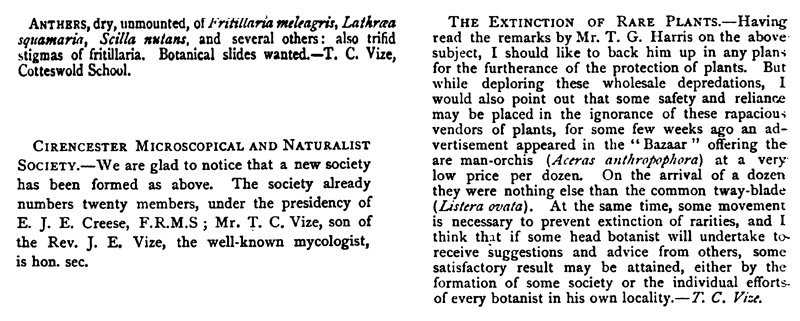
Figure 5.
An exchange offer, a letter and an editorial note regarding John’s son, Thomas. All from 1881 issues of
‘Hardwicke’s Science-Gossip’.
Vize continued his relationship with the microscopists of Manchester, periodically being acknowledged for donations to their slide cabinet. He was also a member of other societies, such as the Woolhope Naturalists' Field Club of Herefordshire. An 1889 article on the Woolhope Club noted that Vize’s knowledge of microscopic fungi was “almost inexhaustible” (Figure 6).
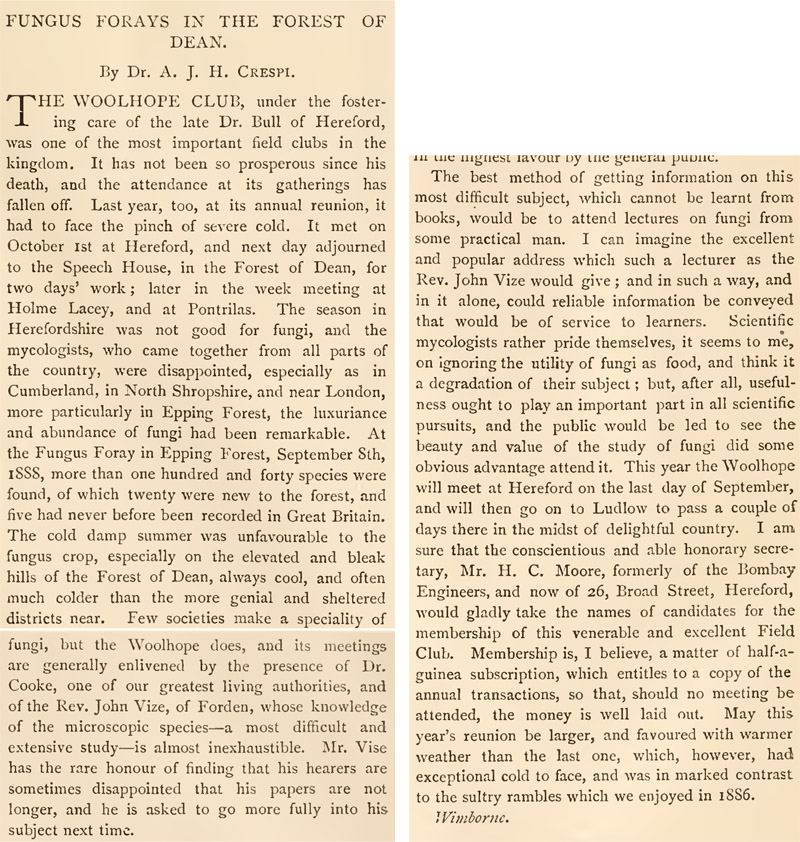
Figure 6.
On the Woolhope Club and J.E. Vize,
from Hardwicke’s Science-Gossip, 1889.
John Vize retired from his vicarage around 1910. Hannah had been ill for the past decade, and John’s eyesight was failing. They, and Clara, moved to Bristol. Hannah died in 1912, and John died in 1916, at the age of 85.
As a final note, we could all benefit from emulating early scientists such as Reverend Vize. While it is commonly assumed that one must now be a professional scientist to study anything worthwhile, that is not true. The vast majority of modern scientific research focuses on humans, such as diseases of humans and crops, agricultural insect pests, etc. That omits the vast majority of organisms on earth, most of which are barely known to science. There is still ample room for amateur scientists to conduct significant studies and publish their results.
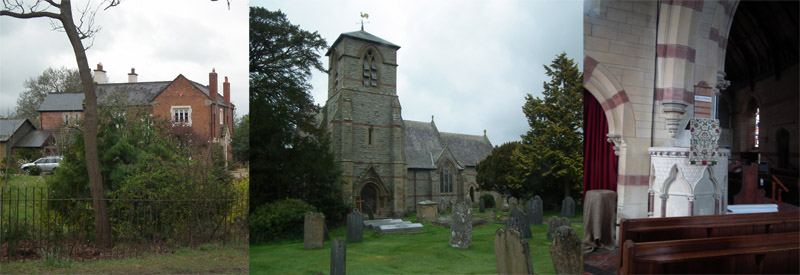
Figure 7.
Modern photographs of the Forden Vicarage (left) and the Forden Parish Church. Curtesy of Steve Gill.
Acknowledgements
Thanks to Steve Gill for sharing his photographs of Forden, and to Shirley Hancock and T.F. Preece of the Shropshire Fungus Group for providing information on Rev. Vize.
Resources
Bracegirdle, Brian (1998) Microscopical Mounts and Mounters, Quekett Microscopical Club, London, pages 96 and 178, and plate 37
Chemical News (1868) Manchester Literary and Philosophical Society Microscopical and Natural History Section meeting Nov. 4, 1887, “Rev. J.E. Vize showed and presented to the section four specimens of insects beautifully mounted in balsam by himself”, Vol. 16, page 84
Crespi, A.J.H. (1889) Fungus forays in the Forest of Dean, Hardwicke’s Science-Gossip, Vol. 25, pages 231-234
England and Wales census, birth and marriage records, accessed through ancestry.co.uk
Hardwicke’s Science-Gossip (1881) Exchange offer from T.C. Vize, Vol. 17, page 168
Hardwicke’s Science-Gossip (1881) Note on the Cirenchester Microscopical and Naturalist Society, Vol. 17, page 185
Hardwicke’s Science-Gossip (1888) Exchange offer from J.E. Vize, Vol. 24, page 47
Hardwicke’s Science-Gossip (1889) Exchange offer from J.E. Vize, Vol. 25, page 72
Hardwicke’s Science-Gossip (1889) Advertisements for lectures from J.E. Vize, Vol. 25, pages lxx and elsewhere
Hardwicke’s Science-Gossip (1893) Exchange offer from J.E. Vize, Vol. 29, page 24
http://vizefamilyhistory.wikia.com/wiki/Rev_John_Edward_Vize_1831-1916 (accessed September, 2013)
Journal of the Royal Microscopical Society (1878) Vol. 1, pages 159-161
Journal of the Royal Microscopical Society (1880) Series 2, Vol. 1, page 153
Manchester Microscopical Society Annual Report and Transactions (1889) page xxiii
The Midland Naturalist (1882) Vol. 5, pages 147-148
The Microscopical News and Northern Microscopist (1884) Advertisement from J.E. Vize on inside front cover, Vol. 4, January issue
Monthly Microscopical Journal (1872) Vol. 7, pages 130-131
Monthly Microscopical Journal (1877) Vol. 18, pages 44-45
Northern Microscopist (1880) Vol. 1, page 35
Proceedings of the Manchester Literary and Philosophical Society (1867) Vol. 6, pages 181-182
A Review of the Work of the Leeuwenhoek Microscopical Club, Manchester, From October, 1867, to March, 1891. in Pamphlets on Protozoology (Kofoid Collection), Vol. 298, page 323, on line at http://books.google.com/books?id=jmA0AAAAIAAJ
Royal Microscopical Society Charters and Bye-laws, List of Fellows (1892) “1879 Vize, Rev. John Edward, M.A.; Hon. Mem. Woolhope Naturalists' Field Club, Hon. Corr. Mem. Cryptogamic Society of Scotland. Forden Vicarage, Welshpool”, page 48
The Shropshire Fungus Group, http://shropshirefungusgroup.org/ (accessed September, 2013)
Vize, John E. (1879) The genus Peronospora (to which the potato disease belongs) and its allies, Collections Historical & Archaeological Relating to Montgomeryshire, Vol. 12, pages 167-182
Vize, John E. (1882) An introduction to the study of fungi, The Northern Microscopist and Microscopical News, Vol. 2, pages 8-12
Vize, John E. (1882) The history of the Forden Union Graveyard, Collections Historical & Archaeological Relating to Montgomeryshire, Vol. 15, pages 27-40
Vize, John E. (1882-1884) The Parish of Forden,Collections Historical & Archaeological Relating to Montgomeryshire, Vol. 15, pages 155-182; Vol. 16, pages 193-208; and Vol. 17, pages 81-120
Vize, John E. (1892) The microscope as applied to fungology, Transactions of the Woolhope Naturalists’ Field Club, pages 70-72
Vize, T.C. (1881) The extinction of rare plants, Hardwicke’s Science-Gossip, Vol. 17, page 260